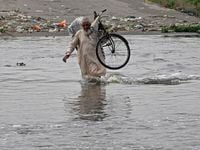Pakistan and India’s Punjab region are reeling from catastrophic floods that have left a trail of destruction, exposed deep-seated vulnerabilities, and reignited debates over climate justice and disaster relief. Since late June 2025, heavier-than-usual monsoon rains and sudden cloudbursts have battered the subcontinent, triggering widespread flooding that has devastated millions of lives, livelihoods, and vital infrastructure.
In Pakistan, the toll has been staggering. According to the United Nations, more than six million people have been affected nationwide by the floods as of mid-September, with over 1,000 lives lost and more than two million displaced from their homes. The National Disaster Management Authority reported that more than 12,500 houses have been damaged and 6,500 livestock lost, compounding the misery for families who rely on agriculture and animal husbandry to survive. Crops across the country have been destroyed, threatening food security and the backbone of the nation’s economy.
The floods, described by officials as among the worst in decades, have laid bare the acute vulnerability of Pakistan to the whims of a changing climate. Musadik Malik, Pakistan’s climate change minister, did not mince words when speaking to Al Jazeera. He lambasted what he called a “crisis of justice” facing his country, pointing out that while Pakistan contributes less than 1 percent of global carbon emissions, it ranks among the world’s top 10 most climate-vulnerable nations. “Around 50 to 55 percent of Pakistan’s population is engaged in agriculture,” Malik explained. “Our agricultural system is predominantly sustained by canals and rivers, with some reliance on rainfall. Pakistan is home to some 13,000 glaciers. If these glaciers, due to global warming and increased carbon emissions primarily from developed economies, begin to melt erratically and at a much faster rate… imagine the impact on our river system, our barrages and subsequently our canal network. This would have catastrophic consequences for Pakistan’s agricultural economy.”
Malik’s concerns are not merely hypothetical. The erratic nature and increasing frequency of floods over the past 10 to 15 years have led to alarming losses of life and property. “When these floods hit, they cause immense mortality, morbidity and widespread displacement. Just a few years ago in Sindh, thousands of years of civilisation were literally washed away – mosques, temples, schools, hospitals, old buildings and monuments,” Malik said. The aftermath is severe: loss of education, limited access to healthcare and clean drinking water, a surge in waterborne diseases, and increased infant and child mortality.
Pakistan’s environmental woes extend beyond flooding. Malik highlighted the worsening air pollution, with smog replacing the mist and fog that once blanketed cities in Punjab, making travel hazardous and even causing discomfort upon arrival. Water pollution is equally dire. “Our flowing waters, once considered pristine and a symbol of civilisation, are now largely poisoned,” he noted. Solid waste management is another challenge, as landfills contribute to ammonia emissions and rising temperatures, which in turn accelerate glacier melting and disrupt the climate patterns crucial for agriculture.
Underlying these environmental crises is a profound sense of injustice regarding global climate financing. Malik criticized the “lopsided allocation” of international funds, stating, “Two countries [China and the US] alone produce 45 percent of the world’s carbon emissions… The top 10 countries account for more than 70 percent of the global carbon burden. Yet, astonishingly, 85 percent of the world’s green financing for building climate resilience and adaptation infrastructure goes to these same 10 countries. The remaining 180-plus countries, like ours, receive only 10 to 15 percent. This is a joke. What resilience or adaptation can we build with such negligible financing?” He called for a fairer, more equitable distribution of funds, warning that without it, the suffering of the world’s most vulnerable will only deepen.
Despite these challenges, Malik maintained that Pakistan would not shirk its responsibilities. “Our children are our responsibility so we will address these challenges whether we receive adequate funding or not. We are embracing our vulnerability, not just lamenting it,” he said, emphasizing adaptation strategies and local resilience efforts even in the face of limited resources.
Across the border in India’s Punjab region, the story is eerily similar. The Punjab Government recently announced a special session of the state Assembly, set for September 26 to 29, 2025, to introduce amendments related to compensation for flood victims. The scale of destruction has been immense: more than 2,300 villages submerged, over two million people affected, and approximately 500,000 acres of crops destroyed. Chief Minister Bhagwant Mann reported that 57 lives have been lost and around 700,000 people rendered homeless by the floods.
The infrastructure damage is staggering. According to Mann, 3,200 government schools, 19 colleges, 1,400 clinics and hospitals, 8,500 kilometers of roads, and 2,500 bridges have been destroyed. Initial estimates place the total damage at approximately Rs 13,800 crore, though Mann warned the real figure could be even higher. The flooding was primarily caused by swollen Sutlej, Beas, and Ravi rivers, along with seasonal rivulets that overflowed after heavy rainfall in catchment areas in Himachal Pradesh and Jammu and Kashmir. The worst-hit districts include Gurdaspur, Amritsar, Kapurthala, Pathankot, Hoshiarpur, Ferozepur, Fazilka, and Tarn Taran.
Mann has been vocal in his appeals to the central government for support. He urged Prime Minister Narendra Modi to release Rs 60,000 crore of Punjab’s funds, which he said are “stuck” with the central government. Mann also called for a revision of the norms governing the State Disaster Response Fund (SDRF), arguing that the current guidelines are “grossly inadequate to compensate farmers, livestock owners, and vulnerable communities for the scale of their losses.” During his recent visit to Punjab, Prime Minister Modi announced financial assistance of Rs 1,600 crore, a sum that, while significant, falls far short of the state’s estimated needs.
The Punjab government is determined to provide substantial relief, rehabilitation, and recovery for those affected. Mann emphasized the administration’s “unwavering” commitment, stating that “the decisions taken during this special session will provide substantial relief to flood-affected citizens.” The state’s efforts are focused on ensuring that no stone is left unturned in the path to recovery.
As both Pakistan and India’s Punjab region grapple with the aftermath of these devastating floods, the events have brought renewed urgency to the global conversation on climate justice, adaptation, and the responsibilities of wealthier nations. The suffering of millions on the subcontinent serves as a stark reminder that the impacts of climate change are not distributed equally, and that those who have contributed least to the crisis often bear its heaviest burdens.
With communities on both sides of the border facing daunting challenges, the call for fairer financing, robust adaptation strategies, and international solidarity has never sounded more urgent—or more justified.

